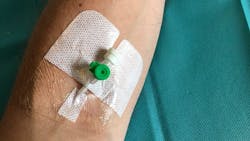White paper shows catheter-related IP efforts must broaden to protect patient safety
entrotech life sciences, inc. has released a new white paper that addresses the urgent need to expand infection surveillance and prevention efforts to include all types of vascular access devices (VAD) across care settings.
In addition, the paper discusses emerging evidence on evolutionary antimicrobial dressing technology and its role in advancing efforts to prevent bloodstream infections (BSIs).
Author Robert Garcia, BS, MT(ASCP), CIC, FAPIC, an infection preventionist with 40 years of hospital experience and a widely published author and lecturer, suggests a more robust approach to patient safety that focuses on hospital-onset bacteremia (HOB), instead of only central line associated bloodstream infections (CLABSIs). Supported by extensive evidence, HOB is an evolving and broad prevention concept that addresses infections related to all types of VADs, including peripherally inserted central catheters (PICC), midlines and peripheral IV (PIV) catheters.
Currently, CLABSIs are the only bloodstream infection (BSI) category with mandatory reporting requirements. But as Garcia notes, the CLABSI metric only reflects a narrow subset of all catheter-related bloodstream infections (CRBSIs).
“While there is some data on BSIs associated with other types of IV catheters, without mandatory reporting, we don’t have a clear picture of how often they occur, which means that catheter-related infections are probably more extensive than we even realize,” said Garcia. “We must expand surveillance beyond CLABSI and move to a broader program of HOB prevention, where the same standard of care that we apply to central lines is applied to all vascular access lines.”
Garcia’s recommendations align with recent concerns about catheter-related complications raised by the healthcare quality and safety organization, ECRI (Plymouth Meeting, PA). Earlier this month, the nonprofit technology assessment group released its annual list of Top 10 Patient Safety Concerns, which includes infections and other complications associated with peripheral IV catheters (PIVC). This is the second time ECRI has identified PIVC infections as a major patient safety issue in recent years, noting in their 2019 report that “increased awareness of PIV-catheter-related infections, coupled with routine active surveillance and follow-up reporting, can help reduce the risk.”
According to Garcia, there is also emerging evidence that novel antimicrobial dressing technology may provide a significant advancement in HOB prevention. The technology takes the proven antimicrobial protection of chlorhexidine dressings to the next level by utilizing pure chlorhexidine (CHX) to provide rapid and broad-spectrum protection at catheter sites. This next generation of antimicrobial dressings uses chlorhexidine to a fuller extent, making the antimicrobial agent more effective against bacteria and other organisms on the skin for longer periods of time, which is “truly a breakthrough,” Garcia said.
PrevahexCHX is an antimicrobial dressing cleared by the FDA with pure chlorhexidine coverage throughout the transparent areas of the dressing, which is designed to provide rapid onset of antimicrobial protection and lasts for up to seven days to help prevent CRBSIs and surgical site infections (SSIs).
A recent study published in the Journal of Wound Care examines the in vitro antimicrobial effects of a chlorhexidine diacetate (CHA) and silver salt-based antimicrobial dressing against the free-base chlorhexidine (CHX) dressing. In the study, the antimicrobial performance of the CHX dressing was superior to the CHA dressing at 67% of experimental time points, with at least equivalent efficacy at all other time points. The CHX dressing also demonstrated significant antimicrobial efficacy at a much faster rate, particularly at the one-day time point, suggesting that the use of pure CHX may provide a more rapid and effective alternative to dressing technologies that rely on conventional chlorhexidine formulations.
Chlorhexidine has long been utilized as a medical antimicrobial agent, with its pure form being most effective. Other chlorhexidine formulations contain additives such as gluconic acid and acetic acid that can potentially irritate the skin upon application. PrevahexCHX dressings are free of these additives, ensuring a comfortable patient experience. The dressing is manufactured through a revolutionary non-thermal, PCA-free process that ensures the rapid onset of action of pure chlorhexidine, as well as the breathability and visibility of the wound and catheter site.
